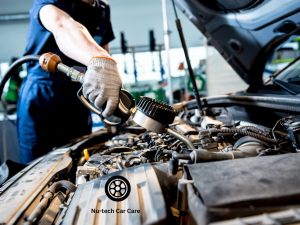Regular tyre tech maintenance is crucial for ensuring the safety, performance, and longevity of your vehicle. Properly maintained tyres enhance driving stability, improve fuel efficiency, and reduce the risk of accidents caused by tyre failure. By incorporating regular tyre checks into your car service routine, you can avoid unexpected breakdowns and costly repairs.
Overview of Key Tyre Maintenance Practices
Effective tyre maintenance involves several key practices, including maintaining proper tyre pressure, regular tyre rotation, checking for wear and tear, and ensuring proper alignment and balancing. Each of these practices plays a vital role in keeping your tyres in optimal condition, thereby extending their lifespan and enhancing overall vehicle performance.
Proper Tyre Inflation Techniques

Understanding Tyre Pressure: What You Need to Know
Tyre tech pressure is a critical aspect of tyre maintenance that directly impacts vehicle handling, fuel efficiency, and tyre wear. Under-inflated tyres can cause poor fuel economy and uneven wear, while over-inflated tyres may lead to reduced traction and a harsher ride. It’s essential to know the recommended tyre pressure for your vehicle, which can usually be found in the owner’s manual or on a sticker inside the driver’s door.
How to Check and Adjust Tyre Pressure
To maintain proper tyre pressure, follow these steps:
- Use a Reliable Pressure Gauge: Invest in a good-quality tyre pressure gauge to get accurate readings.
- Check Pressure When Tyres are Cold: Measure tyre pressure when the tyres are cold, as driving heats them up and can give a false reading.
- Adjust to Recommended Levels: Inflate or deflate the tyres to match the recommended pressure levels.
- Regular Checks: Check tyre pressure at least once a month and before long trips to ensure optimal performance.
Importance of Regular Tyre Rotation
Benefits of Tyre Rotation
Tyre rotation involves changing the position of each tyre on your vehicle to ensure even wear. Regular tyre rotation can:
- Extend Tyre Life: Even out tread wear across all tyres, increasing their lifespan.
- Improve Performance: Enhance handling and traction by maintaining even tread depth.
- Save Money: Reduce the frequency of tyre replacements and improve fuel efficiency.
Recommended Tyre Rotation Patterns and Intervals
There are different rotation patterns depending on your vehicle type and tyre configuration. Common patterns include:
- Forward Cross: Suitable for front-wheel-drive vehicles, where the front tyres move to the rear on the same side, and the rear tyres cross to the front.
- Rearward Cross: Used for rear-wheel-drive and 4WD vehicles, where the rear tyres move to the front on the same side, and the front tyres cross to the rear.
- X-Pattern: Suitable for 4WD and all-wheel-drive vehicles, where all tyres are moved diagonally.
Rotate your tyres every 5,000 to 8,000 miles or as recommended by your vehicle manufacturer to ensure even wear.
Checking for Tyre Wear and Tear

Identifying Common Signs of Tyre Wear
Regularly inspecting your tyres for signs of wear can help prevent potential issues. Look for:
- Tread Depth: Worn tread reduces traction, especially in wet conditions. Use a tread depth gauge or the penny test to check.
- Cracks and Bulges: These indicate structural damage and can lead to tyre failure.
- Uneven Wear Patterns: This could be a sign of misalignment, improper inflation, or suspension issues.
How to Measure Tyre Tread Depth
To measure tread depth:
- Tread Depth Gauge: Insert the gauge into the tread grooves to get an accurate reading.
- Penny Test: Insert a penny into the tread with Lincoln’s head upside down. If you can see the top of Lincoln’s head, the tread is too worn and the tyre should be replaced.
Balancing and Alignment
Importance of Tyre Balancing for Smooth Driving
Tyre balancing ensures that the weight of the tyre tech and wheel assembly is evenly distributed around the axle. Proper tyre balancing is crucial for:
- Smooth Driving Experience: Unbalanced tyres can cause vibrations, leading to an uncomfortable ride.
- Extended Tyre Life: Evenly balanced tyres wear more evenly, prolonging their lifespan.
- Preventing Vehicle Damage: Unbalanced tyres can cause premature wear on suspension and steering components.
Ensuring Proper Wheel Alignment for Tyre Longevity
Wheel alignment involves adjusting the angles of the wheels so they are set to the car manufacturer’s specifications. Proper alignment is essential for:
- Tyre Longevity: Misaligned wheels cause uneven tyre wear, reducing their lifespan.
- Improved Handling: Correct alignment ensures that the vehicle handles properly, enhancing safety.
- Fuel Efficiency: Properly aligned wheels reduce rolling resistance, improving fuel efficiency.
Selecting the Right Tyres for Your Vehicle

Choosing Tyres Based on Driving Conditions and Habits
Selecting the right tyres depends on your driving conditions and habits. Consider the following:
- Climate: Choose tyres suitable for the climate, such as all-season tyres for moderate climates or winter tyres for snowy conditions.
- Terrain: Select tyres designed for the terrain you drive on, such as off-road tyres for rugged terrain or performance tyres for highways.
- Driving Style: Your driving style also influences tyre choice. Performance-oriented drivers may prefer tyres that offer better handling and grip.
Understanding Tyre Specifications and Ratings
When selecting tyres, it’s important to understand the specifications and ratings, including:
- Tyre Size: Ensure the tyres match the size recommended by the vehicle manufacturer.
- Load Index: Indicates the maximum load a tyre can carry. Choose tyres with a load index that meets or exceeds your vehicle’s requirements.
- Speed Rating: Denotes the maximum speed a tyre can handle. Select a speed rating suitable for your driving habits.
Seasonal Tyre Maintenance Tips
Preparing Your Tyres for Winter
Winter conditions require specific tyre maintenance practices:
- Switch to Winter Tyres: Consider using winter tyres designed for improved traction on snow and ice.
- Check Tyre Pressure Frequently: Cold weather causes tyre pressure to drop, so check and adjust it regularly.
- Inspect Tread Depth: Ensure your tyres have adequate tread depth for better grip on slippery surfaces.
Summer Tyre Care: What to Look Out For
Summer heat can also affect tyre performance:
- Check for Over-Inflation: Hot weather can cause tyres to over-inflate, so monitor pressure levels.
- Inspect for Cracks and Bulges: Heat can exacerbate tyre damage, so look for any signs of wear.
- Rotate Tyres Regularly: High temperatures can cause uneven wear, making regular rotation important.
Integrating Tyre Tech into Your Car Service Routine

Using Tyre Pressure Monitoring Systems (TPMS)
Modern vehicles often come equipped with Tyre Pressure Monitoring Systems (TPMS), which provide real-time information about tyre pressure. Benefits of TPMS include:
- Improved Safety: TPMS alerts you to under-inflated tyres, reducing the risk of blowouts.
- Enhanced Fuel Efficiency: Properly inflated tyres improve fuel efficiency.
- Extended Tyre Life: Maintaining the correct tyre pressure helps prevent premature wear.
Leveraging Modern Tyre Tech for Better Maintenance
Incorporate the latest tyre tech innovations into your car service routine for optimal maintenance:
- Digital Tyre Gauges: Use digital gauges for precise pressure readings.
- Smart Tyres: Consider tyres with built-in sensors that monitor pressure, temperature, and tread depth.
- Mobile Apps: Utilize apps that track tyre maintenance schedules and provide reminders for checks and rotations.










